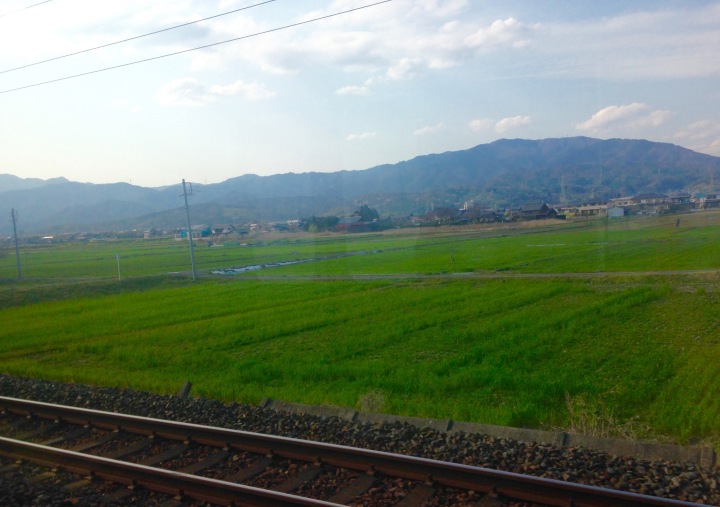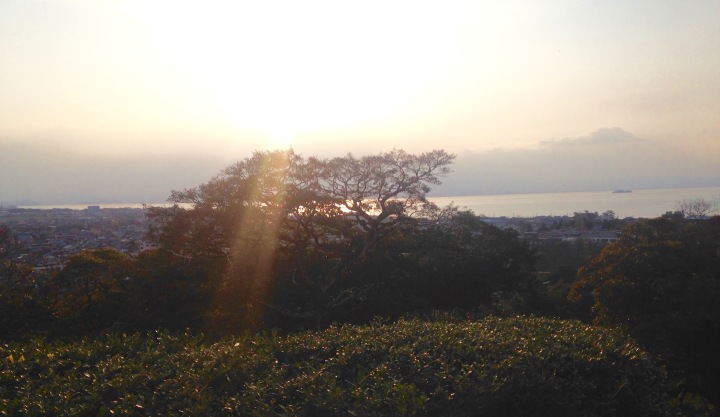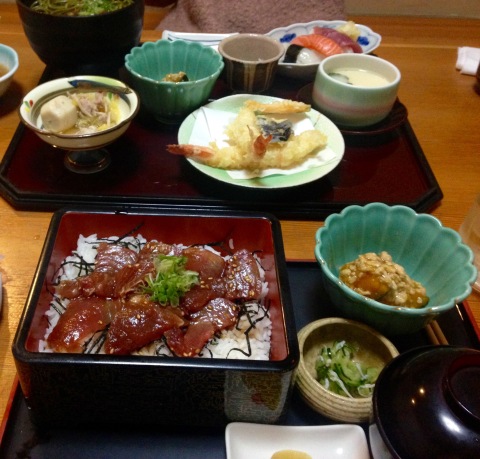I’m starting this post not in the best place for blog posting– sitting on the awkward half-seats in the middle of the train corridor next to the door. The area we’re passing through right now is so inaka (countryside) that the doors don’t automatically open when the train stops, and in fact few passengers of this four-car train are alighting at any of the in-between stops, and only a small collection of houses (no businesses) can be seen from the train stations. The LED sign above the door says our next step in “Nanjo.” The tiny train keeps cutting in and out of the mountains (and dropping my wifi signal), but at the moment it’s floating over sprawling green rice fields flowing out from each side of the tracks.
For the last two days my friend and I have been en route from Tokyo to Kanazawa, a pretty famous city on the opposite coast of Japan, often described as a “tiny Kyoto” for all of its traditional buildings and Edo-period streets and teahouses. As per usual, we had to find a way to do this trip on the cheap, so the incredibly convenient shinkansen (bullet train) was out of the question. Instead, we bought these special seasonal train passes called “seishun 18 kipu” (literally “youth 18 ticket,” inexplicably, because it’s actually available to passengers of all ages. The train website has to clarify several times that there’s actual no age-related discount associated with the ticket, despite the name). The ticket is great because it allows for unlimited train travel over 5 days for only 11850yen (~$100), which is super cheap by Japan transportation standards. But the catch is that you can only travel on local trains, so a journey width-wise across the island, like we’re doing, takes a solid 12 hours.

Yesterday, we did the bulk of our train traveling so we could arrive at Kanazawa somewhat early in the day today, so we travelled around 8 hours from Tokyo to a city right on the edge of Lake Biwa (the largest lake in Japan) called Hikone. At 7:45am we found each other in the busy, chaotic Tokyo station, drawn to the same bakery next to our train platform, and there we stocked up with coffees, pastries, and a couple sandwiches for our long journey. As it turns out, traveling all day by local trains is just as pleasant as you might’ve hoped it would be. As my friend described it, it was basically like sitting in a cafe for a while chatting, except the scenery around us keeps changing interestingly. Especially as we came closer to Hikone, the surroundings became more and more fascinatingly remote, with some station areas sprinkled with only a few farmhouses. As she described it, there was something “unsettling” in the profound remoteness, but that only served to intensify its beauty.

Around noon we alighted for a 30 minute break between transfers at a random town called Shimada, so we exited the ticket gate and strolled off in search of some coffee. Almost the entire town was closed, since it was Sunday, but we did pass a little bookstore, where a group of young Japanese folks seemed to be mid-preparation for some event, which turned out to be a “used book exchange.” Unfortunately, their event wasn’t supposed to begin for another 30 minutes (exactly the breadth of our layover). We asked if we could purchase coffee from the little stand that a guy seemed to be assembling outside. But this was also not ready yet, so instead one of the girls from inside the store came out and asked us to follow her, in a combination of Japanese and broken English, and led us down the main street and through a series of alleys that we never would’ve found on our own, until we suddenly came upon an adorable little cafe. The front of the cafe was an open take-out window with a small outdoor bar and 2 barstools, upon one of which was sitting a young Japanese girl, smoking and eyeing us with a combination of interest and suspicion as we approached. She called to the owner inside when we stopped out front, and after I said a few exchanges in Japanese, she started to look upon us with more calm interest, and finally asked us where we were from, in Japanese. We told her we were Americans, and, before I even had a chance to tell her where in the US I was from she asked, do you happen to know of a town called “Cold Spring Harbor?” I was so shocked I couldn’t even respond for a few seconds– this town is less than a 20 minute drive from my hometown, on the same shore of Long Island, NY that I’m from, and I probably drive through it every single time I’m home. It turns out that she studied abroad at a middle school there for a few weeks many years ago. So over the next few minutes we ran through a list of stores and sights, hoping for a mutual connection, but she must have studied there many more years ago than I expected, because I couldn’t recognize any of the names, so we just marveled together for awhile at the incredibility of it.
Four hours after that, we finally arrived in Hikone. We stuffed our bags in a locker in the Hikone train station and walked towards Hikone Castle–basically the only sight in that area besides the lake. It was a pretty small castle, and felt more like a treehouse inside, but with “spectacular exteriors,” as a sign out front insisted. On our way out, we paused for a good 5 minutes to ask a guard nearby what was the purpose of the caved-in triangular niches along the walls. (From what we could gather, during time of siege, marksmen would aim their guns at the holes, which has a thin, almost false back, and shoot through, unseen, to their enemy below.) The castle grounds were very tranquil, with a small plum orchard in back, and spectacular views of Hikone and Lake Biwa around and below. The lake is so vast that it feels like you’re on the shore of an ocean. The water is a thick and frosty white that pours into an icy fog melting into the shore beyond, so that it looks like the earth is dissolving into this beautiful whiteness.


After the castle, we strolled through a web of dark alleyways to our charming ryokan (Japanese traditional inn). We took a little rest after our busy day of traveling to sip some green tea in our little tatami-mat room before heading to a traditional Japanese restaurant around the corner from our ryokan for a dinner of soba (Japanese buckwheat noodles), sushi, tempura, miso soup, caramelized pumpkin, and several glasses of umeshu (plum wine). To finish our very Japanese day, we took a long soak in our ryokan‘s aloe-infused hot bath, and headed to bed deeply content and ready for an early-morning rise to continue our journey to Kanazawa the next day.

